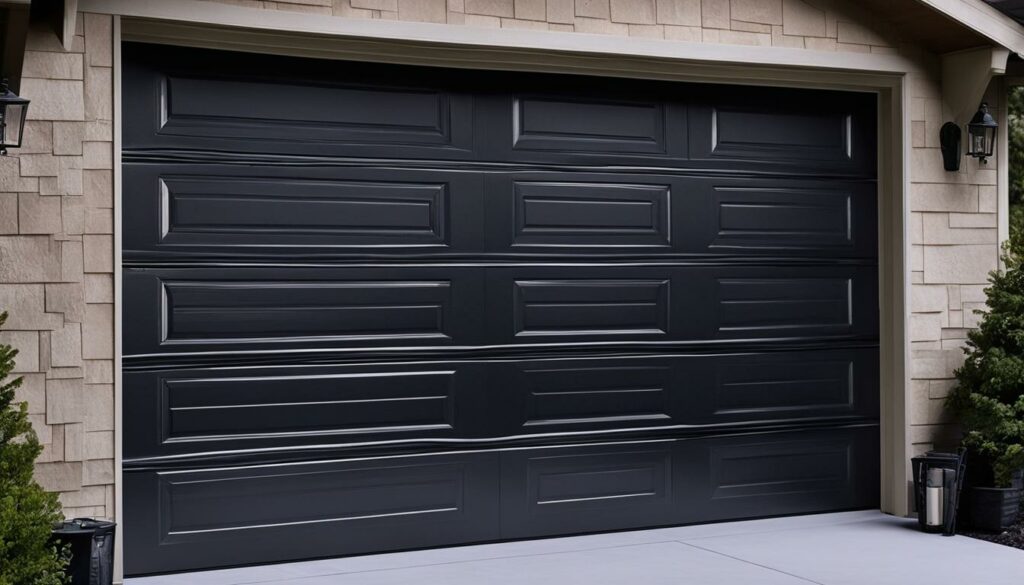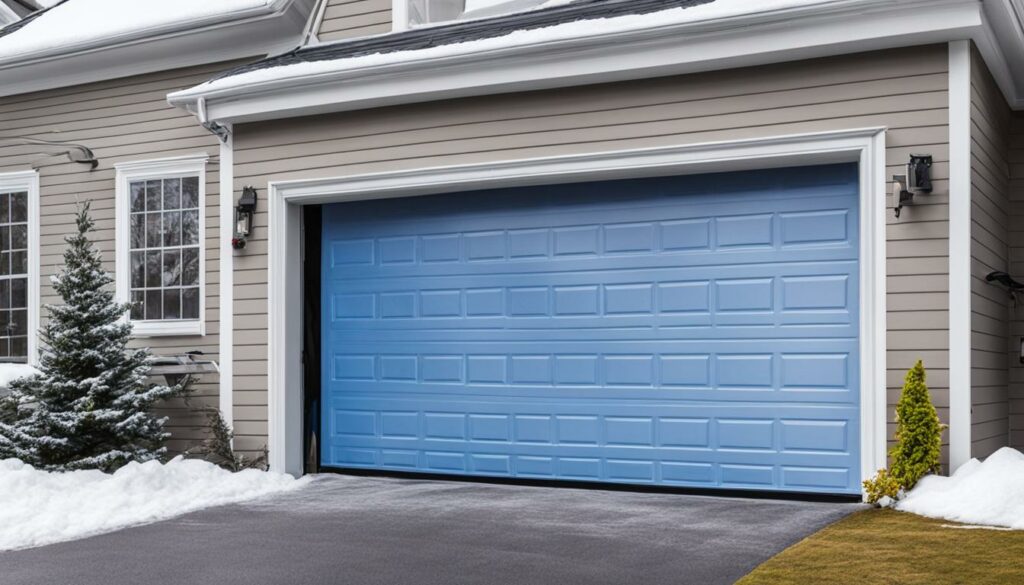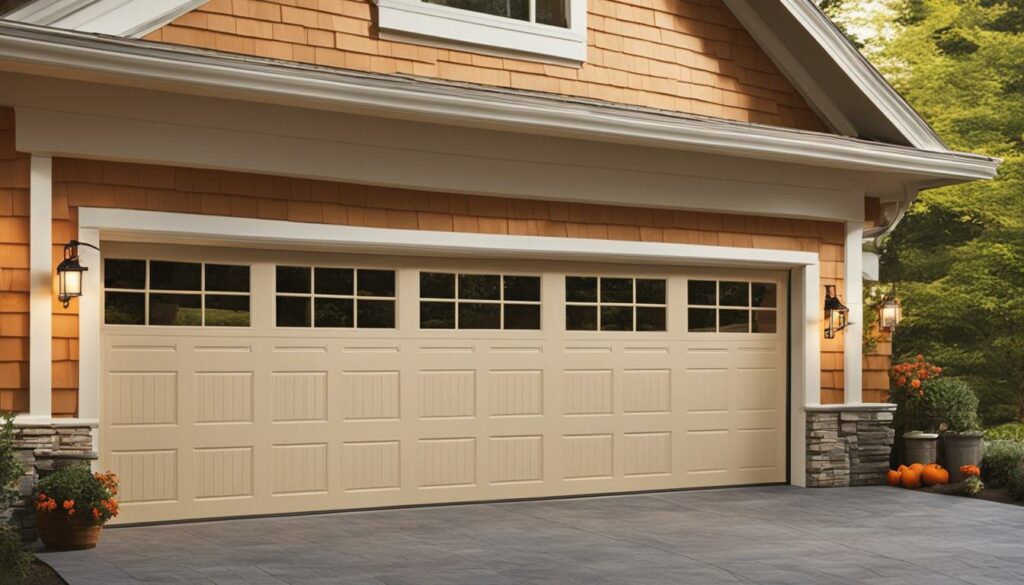Welcome, fellow Aussies! We’re all about making our homes as comfortable and energy-efficient as possible, aren’t we? With energy-efficient garage door insulation, we can do just that. Focusing on the garage might not be the first thing you think of when looking at energy-saving options for your home, but let us tell you, it’s a game changer. Insulating your garage door isn’t just about keeping in the heat in winter; it’s also about creating a space that stays cool during our scorching summers.
An insulated garage door reaps multiple benefits— it dramatically improves your home’s energy conservation, reduces noise, and can even boost the value of your property. When we explore garage door insulation options, we commit to an energy-savvy upgrade that pays off in the long run. The insulated garage door benefits are hard to overlook. So, let’s make our homes the best they can be, starting with the garage!
Key Takeaways
- Garage door insulation is an essential upgrade for comprehensive energy efficiency at home.
- Insulation can lead to energy savings by reducing heating and cooling costs.
- In addition to temperature control, insulation ensures noise reduction, making your garage a quieter space.
- Choosing the right insulation option can enhance your home’s comfort levels throughout the year.
- When selecting insulation, consider the R-value to match your specific climate needs for maximum garage door insulation efficiency.
- Insulation benefits your budget and comfort and can increase your property’s valuation.
The Undeniable Benefits of Insulating Your Garage Door
As we look into ways to improve garage energy efficiency, it’s evident that homeowners stand to gain instant rewards from effective garage door insulation. Let’s delve into the specific advantages insulating your garage door can bring to our homes.
Energy Savings and Reduced Bills
One of the most compelling reasons to invest in insulating your garage door is the potential for energy savings. Our bills have a way of creeping up, but we can keep them in check with adequate insulation. Imagine reducing your energy expenses simply by creating a barrier that resists heat flow—now that’s an intelligent move towards an economical household.
Enhanced Ambient Temperature Control
When it comes to our comfort, temperature control within our homes is non-negotiable. With a well-insulated garage door, we’re looking at consistent, more manageable temperatures, turning an often neglected space into a year-round haven. It’s about transforming our garages into a space where the air feels just right, whether we’re tinkering on a project or the kids are playing around.
Soundproofing from External Noise
Peace can be hard to come by, and if there’s anything we value, it’s a serene ambiance in our homes. By insulating garage doors for energy savings, we also benefit from its sound-dampening properties. The result? A marked decrease in the volatility of karaoke rehearsals or power tools, making our homes sanctuaries of tranquillity.
- It has improved energy efficiency through effective insulation.
- A cozier garage leads to a cozier home, irrespective of the weather.
- A quieter space where the bustle of the outside world doesn’t intrude.
There you have it, mates—a trio of undeniable benefits that make insulating our garage doors an essential and wise choice for any Australian home.
Understanding the Importance of R-Value in Garage Door Insulation Efficiency
We often talk about finding the best insulation for garage doors, and invariably, this conversation turns to the concept of R-value garage insulation. But what does R-value mean for us Aussies trying to enhance our homes’ energy efficiency? Well, it’s all about how well an insulation material can thwart the comings and goings of heat. A higher R-value means better insulation from those pesky temperature swings we’re all too familiar with.
When selecting insulation, the R-value isn’t just a number—it’s a measure of comfort, energy conservation, and cost savings in the long run. We must consider higher R-values, especially if living in parts of Australia with more extreme temperatures. While it’s crucial to know that doubling the R-value doesn’t double the insulation’s effectiveness, each step up the R-value ladder contributes to a warmer winter space and a more relaxed oasis during the summer.
Let’s look at a comparison of typical insulation materials and their corresponding R-values:
| Insulation Type | R-value Range | Material Thickness |
|---|---|---|
| Fibreglass | R-2.9 to R-3.8 per inch | Depends on batt or roll thickness |
| Cellulose | R-3.1 to R-3.8 per inch | Settles to a dense pack with time |
| Rigid Foam | R-4 to R-6.5 per inch | Comes in various board thicknesses |
| Spray Foam | R-6 to R-7 per inch | Depends on application and expansion |
Armed with the knowledge of R-values, we can make more informed decisions on which insulation stands up to our family’s needs. The best insulation for your garage door ultimately comes down to the balance of R-value efficiency, material compatibility with your door type, and the kind of Aussie weather you’re wrangling with.
Remember, improved insulation means a snugger home where the Great Outdoors don’t dictate the comfort of our indoors. So, let’s ensure we pick the proper R-value for a comfy, energy-efficient home. Regarding our garages, as much as we love a good project or a safe spot for our ‘utes,’ we also love keeping our energy bills in check and our living spaces pleasant throughout the year.
Exploring Insulation Materials: Finding the Best Fit for Your Garage
Choosing insulation material is paramount when it’s time to turn our garages into energy-efficient spaces. Australians are looking at various garage door insulation techniques to lower energy bills and enhance comfort. Each option available comes with its own set of benefits and limitations. Allow us to guide you through popular materials like fiberglass, foam, and batt insulation to help determine what will suit your garage door best.

Pros and Cons of Fibreglass Insulation
They often lead the pack when considering fiberglass insulation options for our garage doors. Known for its high R-value, fiberglass insulation is relatively easy to install, as it’s available in pre-cut panels or rolls that fit snugly between the door panels. However, we must remember to gear up appropriately, as fiberglass can irritate skin and lungs.
- Benefits: High thermal resistance, lightweight, ease of installation.
- Drawbacks: Potential for skin and respiratory irritation without proper safety equipment.
The Versatility of Foam Insulation Options
Discussing foam insulation choices, we encounter versatility at its finest. Whether you opt for the spray or rigid foam types, foam stands up to the task with commendable R-values and the ability to conform to various shapes and gaps, ensuring that no heat sneaks through the tiniest cracks. Particularly with spray foam, its expansive nature seals off our garage doors efficiently.
- Benefits: Excellent heat resistance, water resistance, and the ability to fill irregular spaces.
- Drawbacks: Rigid foam requires precise cutting, and spray foam may need professional installation.
Unpacking the Efficiency of Batt Insulation
Lastly, let’s unfold the details of batt insulation explained. Batt insulation, often in fiberglass or mineral wool, presents as blanket-like rolls cut to fit the garage door panels. It’s a practical DIY choice that promises to bolster our garages against the elements.
- Benefits: Easy to handle and install, effective thermal resistance.
- Drawbacks: Ensuring a tight fit is crucial to prevent heat gaps.
In summary, selecting the ideal insulation material depends on the desired R-value for your climate, the budget you’re working with, and your DIY prowess. Each material brings something valuable to the table, whether it’s the reliable thermal barrier of fiberglass, the mouldable versatility of foam, or the straightforward efficiency of batt insulation. Reflect on your individual needs and capabilities, and you’re well on your way to a garage that’s as snug as a bug in a rug.
Garage Door Insulation Efficiency: Maximising Your Home’s Energy Conservation
For us Aussies, our homes are our castles, and just like any good castle, we want to keep the elements at bay while slashing those pesky energy bills. It’s not just about throwing another shrimp on the Barbie; it’s about making smart, sustainable choices that ensure comfort and savings year-round. Enter the hero of our tale: insulating garage door for energy savings. By bolstering our garage doors with top-notch insulation, we’re effectively putting up a stalwart shield that traps heat when Jack Frost is in town and keeps our homes cool as a cucumber during heatwaves.
We’ve got to think beyond the door, mates. Insulating the entire garage – walls and ceiling – creates a fortress of solace from fluctuating temperatures. It’s not just about avoiding a sweat fest when you’re working out in the garage; it’s about the overall energy conservation of your dwelling. A well-insulated garage means our air conditioner and heaters get a bit of a hiatus, leading to energy savings that will have you smiling to the bottle-o.
There’s a ripple effect, too. By keeping your garage temperate, you’re reducing the thermal workload on the rest of your home. It’s a team effort, where every part of the house pulls its weight to keep energy consumption lean and mean. Who wouldn’t want a more efficient home that keeps the coins in your pocket and the comfort level high? That’s a win-win in our books, fair dinkum.

So, how’s your garage fairing in the battle against the elements? If you’ve got drafts that would make a haunted house jealous or a thermometer that’s all over the shop, then it’s time to consider an upgrade. It might seem like a bit of DIY, but it’s a doddle with the proper guidance – and the payoffs are sweeter than a Tim Tam slam.
Remember, mates, insulating your garage door is just one piece of the energy efficiency puzzle. But it’s a corner piece that helps the whole picture come together, giving you a home that’s snug as a bug and gentle on your wallet.
- Comprehensive insulation equals a cozy, energy-smart home.
- Trapping warmth in winter and keeping it out in summer for consistent comfort.
- The domino effect of energy savings – from garage to living room.
Let’s not dilly-dally, then. Maximizing our home’s energy conservation starts with stuffing that garage door with stellar insulation. It’s like putting a snug jumper on your house, keeping it toasty or fresh, depending on the season. And with the energy savings, you may even have a few extra dollars for a holiday. Bali, anyone?
Whether installing the latest shiny solar panels or ensuring your garage door is snug as a bug, every little bit helps. We’re talking about the long game, where investing a bit now for energy efficiency can pay big dividends in the future. So, let’s roll up our sleeves and get cracking on making our homes the bastions of comfort and efficiency they deserve!
DIY or Professional Installation: What’s Best for Your Insulation Project?
Embarking to enhance your home’s garage door insulation efficiency can lead you to a critical crossroads: choosing between the grit and satisfaction of a DIY garage insulation project or the assured expertise of professional insulation installation services. Whichever path you tread, the aim is precise – boosting your home’s energy conservation. So, let’s weigh up our options and decide the best route for our insulation adventure.
Essential Tools and Safety Gear for DIY
You will need the right gear if you’re leaning towards the DIY route. This means equipping yourself with tools like a staple gun, utility knife, and measuring tape and donning the necessary safety equipment. We’re talking about masks, gloves, and safety glasses – the whole nine yards to ensure we’re snug and safe while we snug up our garage. We’ve all got that can-do spirit, but remember, the proper preparation and gear are as crucial as the insulation material.
Step-by-Step DIY Insulation Tips
Roll up your sleeves because it’s time to get stuck into it. We’re tackling this with a straightforward, step-by-step approach. Measure twice, cut once – that’s our mantra for ensuring each insulation panel fits our garage doors to a tee. Align those panels, fill in gaps without squashing the insulation (we don’t want to compromise on that all-important R-value), and secure everything in place. Need a hand? There’s a wealth of DIY insulation guide videos to lead us through the process. Remember, a job well done is as satisfying as a cold one on a hot day.
The Value of Professional Insulation Installation Services
However straightforward DIY might seem, there’s undeniable value in professional installation services. These seasoned pros can take your garage door insulation efficiency to new heights, ensuring the job’s executed with finesse. They’re the go-to for navigating insulation options and understanding R-values, so your garage is prepped perfectly for our sometimes unpredictable Aussie climate. And here’s the kicker: a professional job can crank up your home’s resale value. It might cost a bit more upfront, but the peace of mind and potential payoff can’t be underestimated.
FAQ
What are the benefits of having energy-efficient garage door insulation?
Energy-efficient garage door insulation can significantly improve your home’s comfort by regulating temperature, reducing energy bills, providing a sound barrier against external noise, and increasing the overall energy efficiency of your property.
How does insulating my garage door lead to energy savings?
Insulating your garage door creates a thermal barrier, minimizing heat loss during the cooler months and keeping the interior cool in the summer. This helps maintain a stable temperature and reduces the need for heating and cooling, leading to lower energy consumption and cost savings.
Can insulating my garage door improve the temperature control within my home?
Absolutely. By insulating your garage door, you can enhance the ambient temperature control, ensuring the garage remains a comfortable and usable space throughout the year. Additionally, it can aid in stabilizing the temperature throughout the house, especially if the garage is attached.
What are the advantages of effective garage door insulation in terms of noise?
Effective garage door insulation acts as a sound buffer, significantly reducing external noise transmission. This is particularly beneficial if your garage doubles as a workspace or is connected to your living area, ensuring a quieter indoor environment.
Why is the R-value important when selecting garage door insulation?
The R-value measures the insulation’s ability to resist heat flow. A higher R-value indicates more significant insulation effectiveness. In Australia, choosing insulation with an appropriate R-value is essential to meet the climate-specific energy efficiency requirements and to maximize your garage door insulation efficiency.
What are some common insulation materials for garage doors, and how do I choose?
Common insulation materials include fiberglass, foam, and batt insulation. Your choice depends on factors like the desired R-value, budget, and installation ease. Fibreglass is known for its high R-value and ease of installation; foam insulation is versatile and practical for sealing gaps; batt insulation is helpful for its practicality and good thermal resistance.
Does garage door insulation significantly contribute to my home’s overall energy conservation?
Yes, by installing garage door insulation, you can create a continuous thermal envelope that extends beyond just the door. Insulating the walls and ceiling of your garage can further enhance energy conservation, ensuring more consistent temperatures in both the garage and the home, leading to even more significant energy savings.
Should I attempt DIY garage door insulation or hire a professional?
Deciding between DIY and professional installation comes down to your confidence in your skills, the complexity of the project, and your budget. If you choose DIY, ensure you have the necessary tools and safety gear. However, benefits of professional installation include expert knowledge, the assurance of using the correct materials, and potential increases in property value through high-quality artistry.”
What tools and safety gear are essential for DIY garage door insulation?
For a successful DIY garage door insulation project, you’ll need essential tools such as a tape measure, utility knife, straight edge, staple gun, and adhesive. Safety gear should include a mask, gloves, and safety goggles to protect against insulation materials and dust.
Can you provide any step-by-step insulation tips for those choosing the DIY route?
Indeed, when tackling DIY insulation, start by accurately measuring your garage door panels. Cut the insulation to fit snugly within each panel, ensuring no gaps. If using foam board, seal it with appropriate adhesive. You may need a retaining clip or suitable adhesive to hold fiberglass. Always follow the manufacturer’s instructions for the best results.
What value can professional insulation installation services add to my home?
Professional insulation installation services bring expertise and quality assurance to your project. Specialists will consider all relevant factors, including climate and your specific energy demands, to ensure the highest R-value and installation quality. This not only maximizes the insulation’s performance but can also enhance your home’s resale value through improved energy efficiency.

